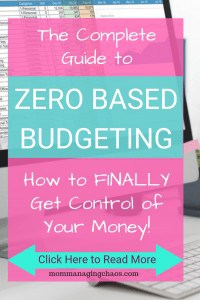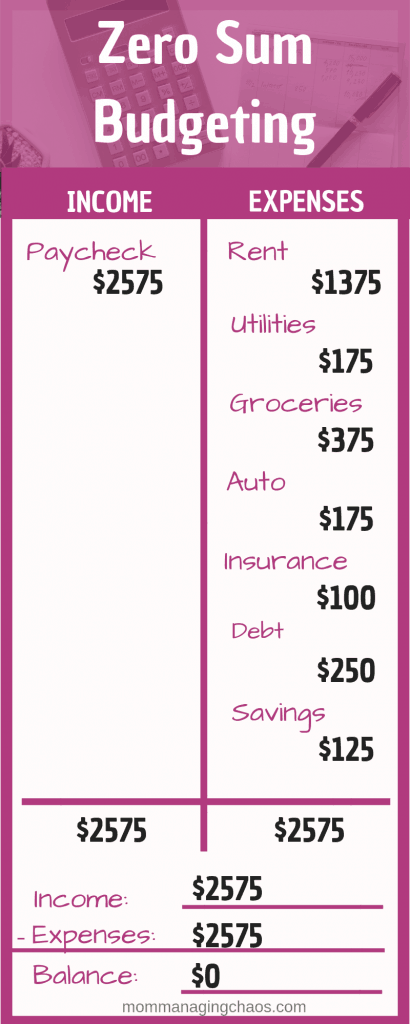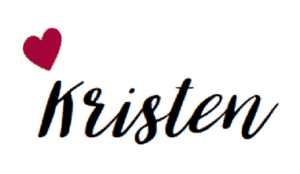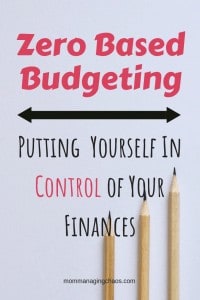Get off the money struggle bus! Check out, what in my opinion, is one of the most effective budgeting methods around– zero based budgeting.
Budgeting was a word I heard quite a bit when I was growing up, but less about the how’s and the why’s.
When I left home and suddenly was responsible for all the “adulting” myself, I had a really hard time figuring out what to do with my money.
I knew that being frugal was important. I knew that staying on budget was important, but what that looked like practically speaking was a complete miss for me.
I struggled mightily with a traditional line item budget. I made my categories, filled in some numbers and then promptly did nothing else with it.
I cringe when I think back on how much money I wasted. Don’t let that be you, dear friend, don’t let that be you.
You tell your money where to go. You decide what your priorities are financially. Get proactive, instead of being reactive!
Zero based budgeting is where it’s at!
Table of Contents
What Is a Zero Based Budget?
A zero-based budget, simply put, is when your income minus expenses equal zero. The key difference between this budgeting method and others, however, is that you budget based on last months income.
I know the idea of budgeting off of last months income may sound daunting, but it’s great for cutting the paycheck to paycheck cycle that most people find themselves in.
One important distinction: Zero-based budgets don’t mean you have zero dollars in the bank at the end of every month. It means that you have given every dollar a job. You aren’t leaving money on the table.
If you find yourself with extra money at the end of the month– it doesn’t necessarily mean a spending free for all!
Having prioritized financial goals in place is a great starting point to look to for “money jobs”!
How to Make a Zero Based Budget
I personally am a big fan of Excel spreadsheets or using Google Docs, but you can do this just as easily with pen and paper if that’s easier!
Step One: What is your monthly income?
Whether you get paid daily, weekly, biweekly, or monthly it doesn’t really matter. Most bills you have coming in will occur on a monthly basis. So ballpark it if you need to, you can always come back and fine tune it when you start getting into the process.
Make a section on your spreadsheet/paper label it income and write down all the money you have coming in for the month.
Step Two: What are your expenses?
Housing (rent or mortgage), utilities, food, gas, phone, etc. Write down everything that you need to set aside money to pay.
I personally like to list my expenses in three different categories:
- Fixed expenses: These are expenses that don’t change from month to month. These would be things like rent, internet/cable, car payments, daycare, etc.
- Variable expenses: These expenses are ones that are necessary, occur regularly, but you have control over how much you are spending on these expenses. An example of flexible spending would be food.
- Discretionary expenses: These are expenses that you choose to spend money on. An example of discretionary spending would be having coffee out, pizza out with friends, brand new shoes, etc.
Step Three: Accounting for Sinking Funds, Emergency Fund, Paying Down Debt and Savings
Sinking Funds: Ya’ll, if you don’t know what I’m talking about when you see the words “Sinking Funds” run, don’t walk, over to my post on Sinking Funds and check out why you need these in your life, like yesterday. This was one area of my budgeting life that played a huge part in helping me stay on budget. Check. It. Out!
The Cliff’s Notes version of sinking funds: These are small “pots” of money (for lack of a better term) that you set aside for irregular expenses or expenses that you know are coming and will need money for: HOA fees, education expenses, new tires, car registration or inspections, etc.
Emergency fund: This is a pot of money you have set aside for emergencies. Emergencies being things like unexpected hospital bills, your car spontaneously combusts…. things like that.
A sale at Nordie’s isn’t an emergency. Crazy good sales would be something you could set up a sinking fund for.
Sinking funds, ya’ll– just do it!
Paying down debt. If you have debt that you are trying to shed like a bad winter coat you should account for that money here.
Savings. If you are contributing to your 401K, Roth IRA, traditional IRA, a 529, mutual funds– whatever. Write that down here as well.
Step Four: Write Down or Revisit Your Financial Priorities
Are you trying to shed debt? Are you saving up for a new house? Need a new car soon? Kid going off to college?
You need to have an idea of where you need to focus the bulk of your time, effort, energy and money to accomplish your goals… also, you need it for step five (below) so that too.
Step Five: Income Minus Expenses Equals Zero
It’s at this point you need to start subtracting all your expenses from your income and the result should be zero.
If you are coming out in the red, go back and readjust. If you are still flush, check out your financial priorities and readjust where your money is going.
The point again, with this budget, is to give every dollar a job.
If you are the kind of person who likes leaving a buffer in your checking account, I get it. I really, really do. BUT chances are unless you are incredibly mindful of your money and have great self-control that buffer often gets blown on stuff that doesn’t really matter.
Every dollar gets a job. G’head give them a job– they want to work for you!
Step 6: Start tracking.
Congratulations! You’ve got your budget all set up. You have given every dollar a job. It’s time for you to start tracking it all.
It’s great that you planned a plan. Now you need to do the plan.
Do yourself a favor! Any time you are trying to make a significant change or create a new habit, it’s gonna be tough and you are going to need to practice tons for it to become the new normal.
Expect that it will be difficult at first.
Please regularly check in on your progress. It is too late at the end of the month for you to reign any spending in– it’s all been spent at that point.
Bonus step: Write a New Budget Every Month
Chances are your month’s budget can and will change. Budgeting isn’t necessarily set it and forget it. Every month you need to make a new budget based on what’s happening in that month. I know things get crazy around the holidays for me.
There is alot of extra travel, gifts to buy (hey, look you could use a sinking fund to plan for that– just saying!), more food to cook and eat, costumes for Halloween, all that Halloween candy!
BLUF (bottom line up front): New month = new budget.
A Simplified Example of Zero Based Budgeting
What are the Pros and Cons of the Zero Based Budget?
The Pros of Zero Based Budgeting:
- This type of budget gives you a hyper-awareness of just where all your money is going.
- It is easy to customize.
- Eases money worry. You don’t need to worry about what bills need to be paid, what is pending, etc. You have a clear and concise plan and you are doing it with last months income!
The Cons of Zero Based Budgeting:
- You have to save up a month of expenses to start. For people with a really tight budget already, it could take you quite some time to get to a place where you have that much money saved.
- You have to make sure you have covered everything in your budget every month. You can find yourself in trouble quickly if you don’t allow enough money for variable expenses, if you forget a bill, etc.
- While it’s still workable, this budgeting method might prove challenging for people with irregular income.
I’d love to hear how this budgeting method worked for you, please comment below!




